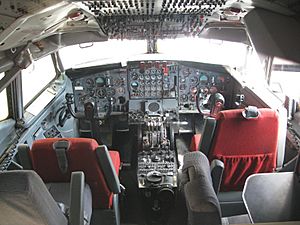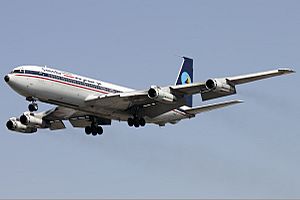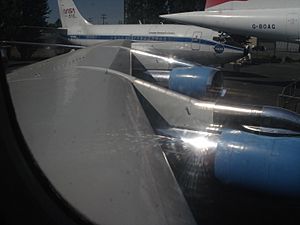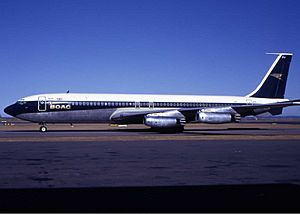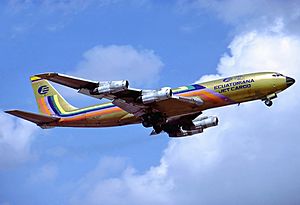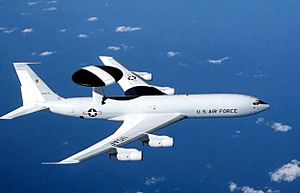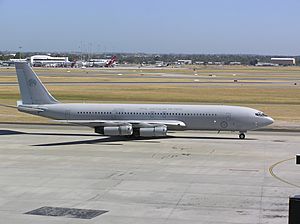Boeing 707 facts for kids
Quick facts for kids Boeing 707 |
|
|---|---|
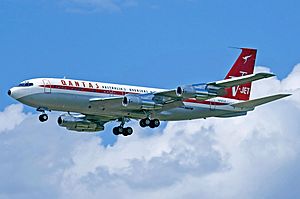 |
|
| A Qantas 707 at the 2007 Paris Air Show. This plane is owned by John Travolta. | |
| Role | Narrow-body jet airliner |
| National origin | United States |
| Manufacturer | Boeing Commercial Airplanes |
| First flight | December 20, 1957 |
| Introduction | October 1958 with Pan American World Airways |
| Status | In service |
| Primary users | Trans World Airlines Continental Air Lines Pan Am BOAC |
| Produced | 1958–1979 |
| Number built | 1,010 |
| Unit cost | US$4.3 million (1955 dollars) US$36.5 million (2012 dollars) |
| Developed from | Boeing 367-80 |
| Variants | Boeing 720 Boeing C-137 Stratoliner |
| Developed into | Boeing E-3 Sentry Boeing E-6 Mercury Northrop Grumman E-8 Joint STARS |
The Boeing 707 is a famous jet airliner. It was built by Boeing Commercial Airplanes from 1958 to 1979. This plane has four powerful engines. It is known as a "narrow-body" plane because it has only two rows of seats. The name is often pronounced "Seven Oh Seven".
Many different types of 707 were made. They could carry between 140 and 189 passengers. These planes could also fly very long distances, from about 2,900 to 6,600 miles (4,600 to 10,600 km).
The Boeing 707 was Boeing's first jet airliner. It was the most popular plane in the 1960s and 1970s. While it wasn't the very first jet airliner, it was the first one to make a lot of money. The 707 helped Boeing become one of the biggest airplane makers. It also started the famous "7x7" series of planes. Other planes like the Boeing 727, Boeing 737, and Boeing 757 used some of the 707's design ideas.
The 707's design came from a special test jet called the Boeing 367-80. The first 707, the 707-120, used Pratt & Whitney JT3C jet engines. Pan American World Airways began using the 707 on October 26, 1958. Other versions, like the 707-138 and 707-320, came out in 1959. A smaller plane, the Boeing 720, was made in 1960. The 707-420 used different engines called Rolls-Royce Conway 508 turbofans.
The 707 was used for many kinds of flights. Military versions include the E-3 Sentry and the C-137 Stratoliner. Boeing built 1,011 707s, including the 720. Many more military planes were also made. By 2012, only a few 707s were still flying for airlines.
Contents
How the Boeing 707 Was Designed
The First Idea: Model 367-80
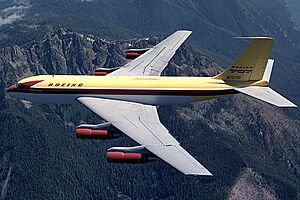
After World War II, Boeing was famous for its military planes. They built important bombers like the B-17 and B-29. But other companies, like Douglas, were making more passenger planes. Boeing wanted to catch up.
In the late 1940s, Boeing started looking into jet planes. The United States Air Force needed new jet fuel tankers. Boeing decided to build a test jet that could be both a tanker and a passenger plane.
Boeing chose a design called the 367–80, or "Dash 80." It took less than two years to build. The Dash 80 first flew on July 15, 1954. It had Pratt & Whitney JT3C engines.
People weren't sure if the 707 would make money. Boeing mostly made money from military planes back then. On August 7, 1955, a test pilot named Tex Johnston did a daring stunt. He performed a barrel roll in the Dash 80 over Lake Washington! This showed how strong and safe the plane was.
The Dash 80 was about 11 feet (3.3 meters) wide inside. This was wide enough for two seats on each side. But a rival company, Douglas, was making their DC-8 plane about 12 feet (3.7 meters) wide. So, Boeing made the 707 even wider, about 12.3 feet (3.76 meters) wide. This allowed for more comfortable seating.
Building and Testing the 707
The first real 707 plane flew on December 20, 1957. The FAA gave it permission to fly passengers on September 18, 1958.
New Versions of the 707
The first type of 707 was the 707-120. Qantas ordered a shorter version, called the 707-138. This shorter plane could fly even further. Braniff International Airways ordered a version with more powerful Pratt & Whitney JT4A engines, called the 707-220.
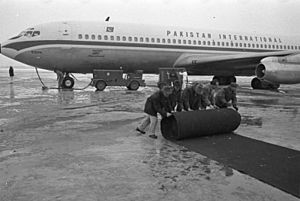
Even though the first 707s used turbojet engines, the Pratt & Whitney JT3D turbofan engine became the most common. Turbofan engines are more fuel-efficient.
The last type of 707 made was the 707-320C. The "C" meant "Convertible." This plane had a large door for cargo. It could be changed from carrying passengers to carrying goods. It also had improved wings.
Boeing stopped making passenger 707s in 1978. They built 1,010 707s for airlines. However, many of these planes were later used by militaries. Boeing continued to make military versions of the 707 until 1991.
Some parts of the 707's design can still be seen in newer planes like the 737, 727, and 757.
How the 707 Was Designed
Wings of the 707
The 707's wings are swept back at a 35-degree angle. This means they are not straight. Boeing created a special device called a yaw damper for these swept-wing planes. This device was needed because swept-wing planes can move strangely without it.
Once, during a flight, the yaw damper was turned off to give new pilots more experience. A pilot made a mistake, and the plane went out of control. Three of the engines broke off the wing. The plane crashed near Seattle, and four people on board died.
In his book, test pilot Tex Johnston wrote about a time he was flying on a 707. He noticed the plane was moving strangely and realized something was wrong with the yaw damper. He went to the cockpit and helped fix the plane.
Engines of the 707
The 707 used air from its engines to keep the cabin pressurized. This means the air inside the plane was kept at a comfortable pressure for passengers.
The P&W JT3D-3B engines had special doors. These doors would open during takeoff to give the engines more air. Once the plane was flying high, the doors would close.
Newer Engines
Later, Pratt & Whitney decided to use the JT8D-219 as a new engine for planes based on the Boeing 707. Many military planes that were designed from the 707 use these newer engines.
History of the Boeing 707
The first orders for the 707 came on October 13, 1955. Pan Am ordered 20 of them. There was a lot of competition between the 707 and the Douglas DC-8. Many large airlines chose the DC-8. Boeing then made changes to the 707's wing so it could fly even further. This new version was called the 707-320.
Pan Am was the first airline to use the 707. The plane's first passenger flight was from New York to Paris on October 26, 1958. It stopped for fuel in Gander, Newfoundland. Qantas was the first airline outside the United States to use the 707.
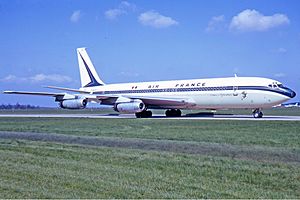
The 707 became a very popular jet airliner. It helped air travel grow a lot around the world. Air traffic control systems also had to be improved because of all the new jet flights.
By the late 1960s, the 707 was becoming too small for all the passengers who wanted to fly. This led Boeing to create the much larger Boeing 747. The 707's engines were also getting old and less efficient.
During the Falklands War, the Argentine Air Force used 707s for patrolling. Some of these planes were spotted by Royal Navy Sea Harrier jets.
Trans World Airlines was the last U.S. airline to fly passengers on a 707. Their last flight was on October 30, 1983.
Today, most 707s are used as private jets or cargo planes.
Different Types of Boeing 707
707-020
This was the first name for the Boeing 720. American Airlines always called their 720s "707s."
707-120
The 707-120 was the first main type of 707. It could hold 179 passengers. This version often had to stop for fuel on flights across the Atlantic Ocean. It had four Pratt & Whitney JT3C-6 turbojet engines. The first passenger flight was on October 26, 1958. Boeing built 56 of these, plus 7 shorter −138 models.
The 707-138 was a −120 that was ten feet shorter. This made it able to fly longer distances.
The 707-120B had newer Pratt & Whitney JT3D-1 turbofan engines. These engines were much better. The −120B also had some changes to its wings. 72 of these planes were made.
707-220
The 707-220 had more powerful Pratt & Whitney JT4A-3 turbojet engines. Only five of these were made, and four were delivered to airlines. The first one started flying in December 1959.
707-320
The 707-320 Intercontinental was a longer version of the 707-120. It could carry more passengers and had some changes to its wings. It first flew on January 11, 1958.
707-420
The 707-420 was similar to the −320, but it used Rolls-Royce Conway 508 engines. Lufthansa was the first airline to use this type of plane for passengers in March 1960.
707-320B
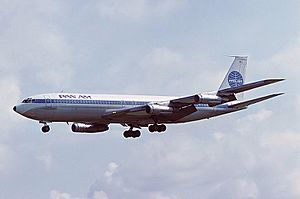
The 707-320B had a few changes to its outside design and new engines. The wing was also improved. Pan Am first used this plane in June 1962.
707-320C
The 707-320C was special because it could be changed from a passenger plane into a cargo plane. More 707-320Cs were made than any other type. It had a large cargo door and other changes to its wing and floor.
Military Versions
Many countries' militaries have used the 707 for different purposes.
The Boeing E-3 Sentry is a U.S. military plane used for airborne warning and control (AWACS). It helps track other aircraft. It is based on the Boeing 707's design.
The Canadian Forces also used Boeing 707s. They were called the CC-137 Husky from 1972 to 1997.
717
Boeing first used the name Boeing 717 for military planes like the C-135 Stratolifter and KC-135 Stratotanker. Later, the McDonnell Douglas MD-95 passenger jet was renamed the Boeing 717 after Boeing bought McDonnell Douglas.
Who Used the Boeing 707?
In the 1980s, the U.S. Air Force bought 250 used 707s. They used parts from these planes for their KC-135E Stratotanker aircraft.
Big airlines no longer use 707s for passenger flights. However, as of December 2012, 10 707s were still in use. Famous actor John Travolta owns a special 707-138B.
Accidents
As of May 2011, the 707 has been involved in 170 "hull-loss" accidents. A hull-loss accident means the plane was so badly damaged that it could not be fixed. Sadly, 2,739 people have died in Boeing 707 accidents.
Details of the Boeing 707
| 707-120B | 707-320B | |
|---|---|---|
| Cockpit crew | Three (Four with a navigator if flying over water) | |
| Passengers | 110 (2-class) 179 (1-class, maximum) |
147 (2-class) 219 (1-class, maximum) |
| Length | 145 ft 1 in (44.07 m) | 152 ft 11 in (46.61 m) |
| Wingspan | 130 ft 10 in (39.90 m) | 145 ft 9 in (44.42 m) |
| Weight when empty | 122,533 lb (55,580 kg) | 146,400 lb (66,406 kg) |
| Cruising speed | 540 knots (1000 km/h) | 525 kn (972 km/h) |
| Width | 12 ft 4 in (3.76 m) | |
| Engines (4 x) | Pratt & Whitney JT3D-1 Rolls Royce Conway (BOAC only): 17,000 lbf (75.6 kN) |
PW JT3D-3: 18,000 lbf (80 kN) PW JT3D-7: 19,000 lbf (84.4 kN) |
Related Planes
- Aircraft related to this one
- Similar aircraft
Images for kids
-
Pan Am started using the 707-120 on October 26, 1958.
-
John Travolta’s 707-138, which is a -120 model shortened by 10 feet.
-
A RAAF 707-320C.
-
The Qantas 707-138B next to a Boeing 747 at the Qantas Founders Outback Museum.
See also
 In Spanish: Boeing 707 para niños
In Spanish: Boeing 707 para niños


